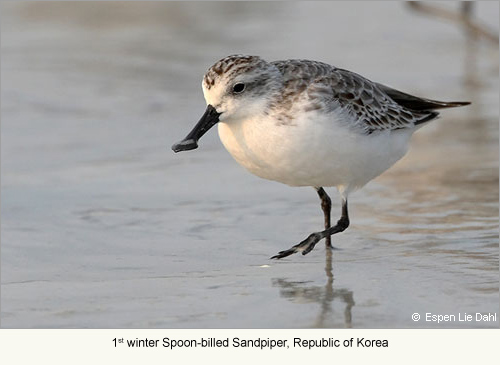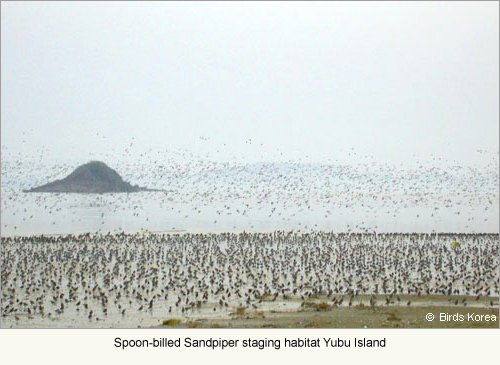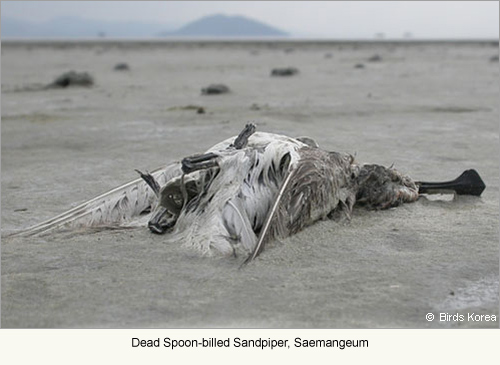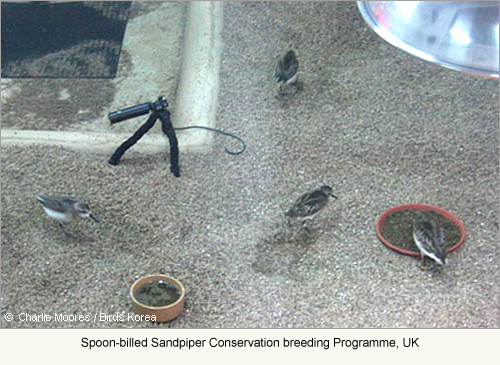a Korean and Yellow Sea Perspective
Introduction
The Spoon-billed Sandpiper Eurynorynchus pygmeus is a charismatic flagship species of intertidal wetlands which has declined rapidly during the past few decades. At present, it is the only regularly-occurring Critically Endangered bird species in the ROK and is considered threatened with imminent extinction. Birds Korea has been the ROK representative of the international Spoon-billed Sandpiper Task Force since 2006. Domestically, we have focused with some success on the conservation of key sites and on awareness-raising. We continue to encourage a national and global consensus on the need for much greater conservation of Yellow Sea intertidal wetlands, for birds and for people, as a core part of genuinely sustainable development. This strategy is based on the scientific understanding that the Spoon-billed Sandpiper is a highly-specialised species, concentrated at a few key estuaries during migration and the boreal winter. The loss and degradation of intertidal wetland has led to the loss of many ecosystem functions and services which people depend on. It has also resulted in massive declines in the Spoon-billed Sandpiper and other shorebird species, and caused the poor global conservation status of the only three waterbird species that are near-endemic to the Yellow Sea during the breeding season: the globally Endangered Black-faced Spoonbill Platalea minor, the globally Vulnerable Chinese Egret Egretta eulophotes and the globally Vulnerable Saunders's Gull Chroicocephalus saundersi (Birds Korea 2010, Moores 2011). Although many people and organisations around the world are now working to conserve the Spoon-billed Sandpiper, no ROK company and no overseas organisation invested in conservation of the Spoon-billed Sandpiper in the ROK in 2011. In 2012 and beyond, the Spoon-billed Sandpiper and Korean wetlands need your support!
Imminent Extinction
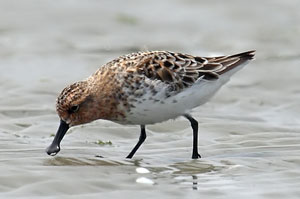
Like many migratory species, the Spoon-billed Sandpiper appears to be threatened in multiple ways, both by single factors (including habitat change, hunting and human-induced climate change) and also by the cumulative impacts of these factors experienced in its breeding, staging and wintering areas. The primary driver of population decline has been habitat change - most especially 'reclamation' (defined here and throughout Birds Korea publications as the conversion of natural wetland into dry land and artificial wetland by mechanical means). The International Single Species Action Plan for the Conservation of the Spoon-billed Sandpiper ("SBS Action Plan") therefore stated unambiguously in the Executive Summary that the "greatest threat to the survival of Spoon-billed Sandpiper is the destruction of the intertidal mudflats that it utilises on migration in China, Japan and Korea and on the wintering grounds in Vietnam, Thailand, Myanmar and Bangladesh" (Zöckler et al. 2010a).
In 2008 pioneering research discovered a substantial overwintering population of Spoon-billed Sandpiper in Martaban Bay, Burma (Myanmar), and also identified hunting as a major cause of mortality there (Zöckler et al. 2010b, 2010c). Several subsequent publications have emphasised the importance of the threat of hunting and inadvertently (or otherwise) under-represented the threat of reclamation. For example, a short note in Nature had the title "Hunting the Cause of a Population Crash", and described the decline of the Spoon-billed Sandpiper as "perplexing" until the threat of hunting had been properly identified (Székely & Sutherland 2010); Zöckler at al. (2010b) stated that the main threats to the population are "poorly known although hunting in the wintering areas has been identified as a major mortality factor", identifying "major loss of their intertidal habitats" under "other threats"; and Pain et al. (2011) considered that "Habitat loss at key staging posts on the bird's 8,000-km migration route to and from its southern and southeast Asian wintering grounds is one factor in this charismatic wader's decline, but recent research suggests that trapping on the wintering grounds may be a key reason for the recent acceleration in the rate of decline". Zöckler et al. (2010b) summarized the situation in this way: "The Bay of Martaban in Myanmar held an estimated 220 Spoon-billed Sandpipers in 2010 and shorebirds are regularly hunted there. A survey of the hunters there indicated that they regularly catch small numbers of Spoon-billed Sandpipers throughout the year. Immature birds may well be more susceptible to capture than adults, as (i) they do not return to the breeding areas until they are two years old and hence are exposed for longer to hunting activities and (ii) young birds have been shown to be more vulnerable to capture in mist-nets than adults... Although habitat loss at staging areas and other threats to the breeding areas may well be important, it is inevitable that high hunting pressure at a site where more than half of the world population winters will have a major impact on the species as a whole." Due to an assumed increase over the past decade or more in the use of fine-mesh nets for bird-trapping and the hunters' indications that Spoon-billed Sandpiper remain in the Bay of Martaban throughout the year (apparently unsupported by robust data), "It is likely that hunting in the wintering area is the major cause of the species' decline" (Zöckler et al. 2010c).
The main international focus of conservation work for the Spoon-billed Sandpiper in 2010 and 2011 therefore shifted towards overwintering areas and included education programs and the support of alternative income-sources for hunters in the Bay of Martaban (essential for reducing accidental by-catch of the species). It also included the development of a captive breeding program. In 2011, 20 eggs were taken from active nests in the Russian Far East, and 17 were hatched. Following a period of transport to the UK and quarantine, 13 birds survived (as of December 2011) and are now in a specially-constructed centre at the Wetlands and Wildfowl Trust centre in the UK (see: WWT web-page). Further eggs will be taken in future years, in order to establish a captive flock for breeding which later might or might not be released back into the wild (perhaps in the 2020s, if major threats to the species can be reduced).
Birds Korea applauds the expertise and the dedication of all of involved in conservation work for the Spoon-billed Sandpiper. We support the SBS Action Plan's assertion that the greatest threat to this (and to a large number of other species) is reclamation and degradation of intertidal wetland, and we also recognise that hunting is a major threat to the Spoon-billed Sandpiper which needs to be stopped if the species is to maintain a viable population. We also applaud the expertise of the captive breeding team. At the same time, we here repeat our concerns about this captive breeding program. Our short-list of recommendations to improve the program's value (previously communicated privately and publicly) includes the need to:
Strengthen legal protections so that inexperienced agencies in other countries do not attempt to initiate their own Spoon-billed Sandpiper captive breeding program;
Ensure that all media statements about the program clarify the need to take greater action to conserve intertidal wetlands and to reduce other threats;
Conduct much more research into feeding ecology and use of habitat during staging and in the boreal winter. This is essential if the wild population is to be conserved, and if the future release of captive birds back into the wild is to be successful.
We also support regional and Flyway-level initiatives taken by the Yellow Sea Large Marine Ecosystem project, the East Asian-Australasian Flyway Partnership and the Australasian Wader Studies Group to highlight the importance of the Yellow Sea. We find great encouragement in the increase in research and conservation actions taken in Burma and China in recent years.
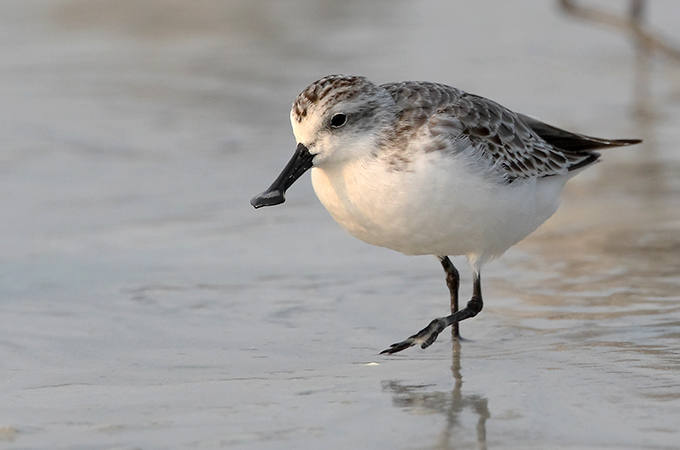
As a Korean organization, we remain determined to support national and international initiatives for Spoon-billed Sandpiper conservation. This first requires a frank assessment of why the conservation status of intertidal wetlands in the ROK continues to deteriorate; of why there is so little domestic consensus on what needs to be done (for this species and its habitat); and of why there is so little financial support available for this work domestically, even though the ROK is a rich nation. While we continue to find ways to raise funds and our own capacity, we remain greatly constrained by the lack of technical and financial support provided to us for this work by domestic bodies and by international organizations. Conservation work for this species in the ROK is also uniquely hampered by the absence in the ROK of any BirdLife International-affiliated organization or international conservation organization - even while our nation hosts international conventions and major meetings (including the IUCN World Conservation Congress in 2012).
In order to improve the national and global conservation status of the Spoon-billed Sandpiper:
Birds Korea calls for an improvement in information-sharing and consensus building within and beyond the Spoon-billed Sandpiper Task Force member organizations. This is in order that all actions taken for the species support other actions so that the collective impact of our work is enhanced. As part of our contribution towards this end, we have opened these pages dedicated to Spoon-billed Sandpiper conservation on our own websites. We also believe that a global, multi-lingual (e.g. Korean, Chinese, Russian, Burmese, Bengali, English and Japanese) web-space dedicated to the Spoon-billed Sandpiper would be a cost-effective and valuable resource to create. We offer our support in providing Korean-language and English-language materials to such a website.
We also call for a clearer recognition in statements and publications to be given to the negative impacts of reclamation and estuarine barrages on shorebird populations, including on the Spoon-billed Sandpiper. Evidence supporting our assertion and that found in the SBS Action Plan is based on the following:
Loss of quality and area of intertidal habitat leads to population declines in dependent shorebird species (Burton et al. 2003, Baker et al. 2004, Burton et al. 2006, Niles et al. 2008, Moores et al. 2008, Moores 2011).
The majority of the world population of Spoon-billed Sandpiper stages at only a few sites in the Yellow Sea during migration (Barter 2002). Most of the adult population probably uses these Yellow Sea sites during northward migration, with the peak in number in the ROK occurring in mid-late May (Moores et al. 2008). This suggests direct migration from the Yellow Sea to (or near to) breeding areas, and also means that the annual peak in the species will have been missed by most previous shorebird survey effort, which has been concentrated in early-mid May (Moores 2011). The importance of the Yellow Sea to the Spoon-billed Sandpiper on northward migration will therefore likely have been underestimated. Moreover, a probably large number of immature birds also stage in the Yellow Sea during northward migration (Birds Korea unpublished data, See LINK). Properly-timed research is required to determine if some of these immature Spoon-billed Sandpiper also oversummer in the Yellow Sea (and if they do so in larger numbers than as speculated in the boreal wintering areas). Most adults and juveniles apparently also stage at the same few key sites in the Yellow Sea during southward migration (Barter 2002, Moores 2011).
Spoon-billed Sandpiper have a "fantastic morphological spoonbill-like bill specialization" (Piersma 2011) that likely confines the species to feeding on certain prey items in a certain way within specific parts of estuarine systems. The largest concentrations of the species to date have all been within the outer parts of especially dynamic estuaries (i.e. Nakdong Estuary, Saemangeum Estuarine System, Bay of Martaban), in those areas with sandy substrates and patches of silt and mud. The distribution of Spoon-billed Sandpiper even within these key estuaries is highly localised (Birds Korea 2010, Bird et al. 2010). Their bill-shape and distribution indicate a high-level of specialisation and presumably makes the species especially vulnerable to habitat change.
There is no evidence that Spoon-billed Sandpiper are able to relocate to new areas once estuaries that support the species are degraded by barrages or are lost to reclamation (Moores 2006, Moores et al. 2008, Moores 2011). Rather, the species declines at affected sites. Increased mortality and a reduction in breeding fitness and success (caused by inadequate staging during northward migration) results in population decline.
There has been, and continues to be, massive loss of intertidal wetland area and quality in the Yellow Sea, with only 25% of historical tidal-flat area now remaining in the ROK (Birds Korea 2010), and massive reclamation projects ongoing in many coastal regions of China (Barter 2002, Barter 2006, Lewis & Russell-French 2011).
The rate of reclamation in East Asia has increased since the 1950s and in the Yellow Sea especially since the 1980s. In Japan, for example, 35% of intertidal area was reclaimed between 1945 and 1978 (Ikeguchi & Okamoto 2008) and the most important shorebird site (Isahaya Bay) was closed off from the sea in the mid-1990s (Zöckler et al. 2010a). The rate of reclamation in the ROK increased rapidly from the 1980s, when the Nakdong and Yeongsan Estuaries were barraged (Long et al. 1988, Birds Korea 2010). More than half of all intertidal wetland in the ROK was lost to reclamation between 1985 and 2010. Many estuaries, both in the ROK and China, are now barraged or have greatly reduced freshwater flow (Moores 2001, Barter 2002). Moreover, in China an estimated 100,000ha of intertidal wetland were reclaimed each year between 2006 and 2010 (Lewis & Russell-French 2011). The increasing rate of reclamation in East Asia and especially in the Yellow Sea coincides well with the increasing rate of decline in the Spoon-billed Sandpiper.
The first known major staging site to be massively degraded was the Nakdong Estuary, through barrage construction in the 1980s; the most recent known major staging site to be lost was Saemangeum, following sea-wall close in 2006 (Moores 2006, Birds Korea 2010); and the species' most important remaining staging site (Rudong in China) is now threatened by reclamation, along with illegal hunting, pollution and the spread of spartina grass (Rudong Spoon-billed Sandpiper Survey Group & China Coastal Waterbird Census Team in lit. 2011).
As a result of reclamation and other threats, both the Spoon-billed Sandpiper and many other migratory shorebird species that are dependent on the intertidal wetlands of the Yellow Sea are believed to be in decline. These declines are taking place at a higher rate than shorebird species which do not depend on the Yellow Sea (Amano et al. 2010, Wilson et al. 2011, Moores 2011, Dr. Nick Davidson in press/2011).
Birds Korea therefore asks, respectfully, for greater support to be given to domestic conservation organizations and initiatives, including those in the ROK, by large donors/financing bodies and international organisations. Already, international support for work in China and Burma has led to much progress and the WWT is running a campaign to raise a further 350,000GBP to fund the captive breeding program (in addition to the 400,000GBP that has already been invested). While such support is absolutely necessary, no donations from ROK companies and no overseas money that we are aware of went towards Spoon-billed Sandpiper conservation in the ROK in 2011. We are also unaware of any donations made by ROK companies to conservation of the Spoon-billed Sandpiper overseas.
The Spoon-billed Sandpiper is, as stated above, the ROK's only regularly-occurring Critically Endangered bird species. Our nation has several wetlands that support Spoon-billed Sandpiper, in addition to having the most active civil society among Yellow Sea nations. We also have numerous eco-centres (including in the Nakdong Estuary and near the Geum Estuary) through which research can be supported and coordinated. Moreover, there is still time to influence the end-use of Saemangeum (and to call for the restoration of tidal-flow there); there is still time to enhance Spoon-billed Sandpiper habitat at the Nakdong Estuary, the Geum Estuary and at Gomso Bay; and there is an increasingly urgent need to develop Korean conservation capacity and materials in order to help support future conservation initiatives in the DPRK. This all requires a substantial increase in investment from within the ROK and from overseas.
For this and for so many other reasons, we ask you to please help support Spoon-billed Sandpiper Conservation in the Republic of Korea.
Please share your Time, Expertise and Financial Support with Birds Korea.
Please invest in a Sustainable Future: Birds, Wetlands and People are One!
To learn more about the Spoon-billed Sandpiper and the work of Birds Korea, go to:


Nial Moores, July 2006
External Links:

- http://www.talking-naturally.co.uk/slimbridges-spoonbilled-sandpipers-unveiled
- http://www.talking-naturally.co.uk/tn49-chris-collins-chukotka-spoon-billed-sandpipers
- http://www.talking-naturally.co.uk/spoon-billed-sandpiper-series-part-three-interview-nial-moores

References
- Amano T., Székely, T., Koyama K., Amano H. & W. Sutherland. 2010. A framework for monitoring the status of populations: An example from wader populations in the East Asian-Australasian flyway. Biological Conservation 143 (2010) 2238-2247.
- Baker, A., González, P., Piersma, T., Niles, L.,. Nascimento, I., Atkinson, P. Clark, N., Minton, C., Peck, M. & G. Aarts. 2004. Rapid population decline in red knots: fitness consequences of decreased refuelling rates and late arrival in Delaware Bay. Proceedings of the Royal Society of London B. 271: 875-882.
- Barter, M. 2002. Shorebirds of the Yellow Sea: Importance, threats and conservation status. Wetlands International Global Series 9, International Wader Studies 12, Canberra, Australia.
- Barter, M. 2006. The Yellow Sea - a vitally important staging region for migratory shorebirds, in: Boere, G.C., Galbraith, C.A., Stroud, D.A., (Eds.). Waterbirds around the world. The Stationery Office, Edinburgh, pp. 663-667.
- Bird, J., Lees, A., Chowdhury, S., Martin, R. & E.U Haque. 2010. A Survey of the Critically Endangered Spoon-billed Sandpiper Eurynorhynchus pygmeus in Bangladesh and key future research and conservation recommendations. Forktail 26: 1-8.
- Burton N., M. Rehfisch & N. Clark. 2003. The Effect of the Cardiff Bay Barrage on Waterbird Populations, Final Report. British Trust for Ornithology Research Report 343.
- Burton, N., Rehfisch, M., Clark, N. & S. Dodd. 2006. Impacts of sudden winter habitat loss on the body condition and survival of redshank Tringa totanus. Journal of Applied Ecology 43:464-473.
- Birds Korea. 2010. The Birds Korea Blueprint 2010 for the conservation of the avian biodiversity of the South Korean part of the Yellow Sea. Published by Birds Korea, October 2010.
- Ikeguchi A. & K. Okamoto. 2008. The Grassroots Movement to Preserve Tidal Flats in Urban Coastal Regions in Japan. The Case of the Fujimae Tidal Flats, Nagoya. Nagoya University, accessed in December 2001 at: www.geogr.lit.nagoyau.ac.jp/okamoto/papers/Ikeguchi%20and%20Okamoto(2008).pdf
- Lewis, J. & A. Russell-French. 2011. Minutes to Midnight. Time is running out for our migratory shorebirds. Wingspan, Autumn 2011 Pp. 35-37. See: http://awsg.org.au/pdfs/minutes-to-midnight.pdf
- Long, A., Poole, C., Eldridge, M., Won P-O & Lee K-S. 1988. A Survey of Coastal wetlands and Shorebirds in South Korea, Spring 1988. Asian Wetland Bureau, Kuala Lumpur.
- Moores, N. 2006. South Korea's Shorebirds: A Review of Abundance, Distribution, Threats and Conservation Status. Stilt 50:62-72. Published by The Australasian Wader Studies Group.
- Moores, N. 2012. The Distribution, Abundance and Conservation of the Avian Biodiversity of Yellow Sea habitats in the Republic of Korea. Doctoral thesis, University of Newcastle, Australia.
- Moores N., Kim S-K, Park S-B and T. Sadayoshi (Eds). 2001. Yellow Sea Ecoregion: Reconnaissance Report on Identification of Important Wetland and Marine Areas for Biodiversity. Volume 2: South Korea. Published by WBK and WWF-Japan, Busan. 142 pages (published in Korean and English-language versions).
- Moores, N., Rogers, D., Kim R-H, Hassel, C., Gosbell, K., Kim S-A & Park M-N. 2008. The 2006-2008 Saemangeum Shorebird Monitoring Program Report. Birds Korea publication.
- Niles, L., Sitters,H., Dey, A., Atkinson, P., Baker, A., Bennett, K., Carmona, R., Clark, K., Clark, N., Espoz, C., González, P., Harrington, B., Hernández, D., Kalasz, K, Lathrop, R., Matus, R.,Minton, C., Morrison, G., Peck, M., Pitts, W., Robinson, R. & I. Serrano. 2008. Status of the Red Knot (Calidris canutus rufa) in the Western Hemisphere. Studies in Avian Biology No. 36. Published by Cooper Ornithological Society.
- Piersma, T. 2011. From spoonbill to Spoon-billed Sandpiper: the perceptual dimensions to the niche. Commentary, Ibis, 153, 659-661.
- Pain, D., Green, R. & N. Clark. 2011. On the edge: can the Spoon-billed Sandpiper be saved? British Birds 104, July 2011: 350-363
- Rogers, D., Moores, N. & P.Battley. 2006a. Northwards Migration of Shorebirds through Saemangeum, the Geum Estuary and Gomso Bay, South Korea in 2006. Stilt 50: 73-89. Published by the Australasian Wader Studies Group.
- Székely, T. & W. Sutherland. 2010. Hunting the cause of a population crash. Nature. Vol 466 July 2010
- Wilson, H., Kendall, B., Fuller, R., Milton, D. & H. Possingham. 2011. Analyzing Variability and the Rate of Decline of Migratory Shorebirds in Moreton Bay, Australia. Conservation Biology, In press. DOI: 10.1111/j.1523-1739.2011.01670.x
- WWT. 2011. Wildfowl and Wetlands Trust. Spoon-billed Sandpiper. Accessed in December 2011: http://www.wwt.org.uk/what-we-do/saving-wildlife/science-and-action/globally-threatened-species/spoon-billed-sandpiper/.
- Zöckler, C., Syroechkovskiy E. & G. Bunting. 2010a. International Single Species Action Plan for the Conservation of Spoon-billed Sandpiper (Eurynorynchus pygmeus). CMS Technical Report Series No. 23).
- Zöckler, C, Syroechkovskiy, E & P. Atkinson. 2010b. Rapid and continued population decline in the Spoon-billed Sandpiper Eurynorhynchus pygmeus indicates imminent extinction unless conservation action is taken. Bird Conservation International (2010) 20:95-111. aBirdLife International, 2010 doi:10.1017/S0959270910000316
- Zöckler, C., Htin Hla, T., Clark, N., Syroechkovskiy, E., Yakushev, N., Daengphayon, S. & R.Robinson. 2010c. Hunting in Myanmar is probably the main cause of the decline of the Spoon-billed Sandpiper Calidris pygmeus. Wader Study Group Bull. 117(1): 1-8.





